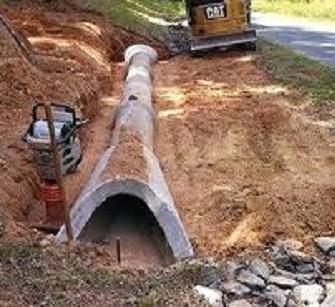Precision Pad Construction for Secure Foundations
Precision Pad Construction for Secure Foundations
Blog Article
Attain Success With Culvert Installation: Best Practices Exposed
Installing culverts is a critical facet of facilities growth, needing accuracy and adherence to best techniques for long-lasting success. Whether undertaking a brand-new project or keeping existing culverts, the process demands meticulous interest to detail. From the preliminary product choice to the last stages of maintenance, each step plays a critical function in the functionality and durability of the culvert system. In this conversation, we will certainly explore necessary techniques, ideas, and guidelines that can significantly affect the outcome of culvert installments. Recognizing these crucial factors is extremely important in making sure the architectural stability and performance of culverts, making it important for specialists and fanatics alike to understand these fundamental concepts.
Appropriate Material Option

Concrete culverts are understood for their strength and resilience, making them suitable for heavy traffic areas and huge water flow volumes. Corrugated metal culverts are light-weight and easy to mount, perfect for short-lived applications or circumstances calling for a fast service. Plastic culverts are light-weight, corrosion-resistant, and cost-efficient, making them a preferred option for numerous culvert installments. Compound materials offer a combination of properties from various materials, providing a personalized service for details project demands. Inevitably, selecting the proper product is necessary to ensure the culvert system functions properly and has a long life span.
Site Preparation Tips
Reliable website prep work is essential for the successful installment of culverts, making sure appropriate integration with the surrounding environment and long-term functionality. Before beginning the setup procedure, it is vital to carry out a comprehensive website assessment to identify the appropriate dimension, kind, and positioning of the culvert. Cleaning the area of any debris, plant life, or blockages is the primary step in website prep work. This makes sure a clean and level surface for the culvert to be installed.
Following, the soil conditions must be assessed to analyze the security and load-bearing ability of the ground. Depending upon the dirt kind, added steps such as compaction or support may be necessary to protect against working out or shifting of the culvert gradually. Appropriate water drainage factors to consider ought to additionally be taken into account to avoid water build-up around the culvert, which can cause disintegration or structural damages.
Lastly, developing proper access to the site for construction tools and guaranteeing compliance with any type of governing requirements are crucial elements of website preparation. By adhering to these site prep work tips, the setup of culverts can be lugged out efficiently and efficiently, advertising the longevity and capability of the culvert system.
Installment Methods

First of all, it is necessary to precisely determine and mark the location where the culvert will be mounted. This makes certain correct placement and stops any type of errors throughout the installation phase. Excavation should be done very carefully to produce a stable structure for the culvert. The trench needs to be dug to the appropriate depth and size, thinking about the size and kind of culvert being mounted.
Next, the culvert ought to be put in the trench complying with the maker's guidelines. Correct positioning is vital for the capability and durability of the culvert. Backfilling the trench with the proper material and compacting it in layers is the final action in the setup process. This makes certain the culvert is firmly in area and all set to withstand the needs it will certainly face. By complying with these installation methods faithfully, the culvert will certainly be successfully installed, adding to the overall success of the job.
Maintenance Guidelines
After finishing the careful installation of culverts complying with correct techniques, adherence to upkeep standards is vital to guarantee their durability and functionality. Normal assessment is vital to identify any kind of signs of wear, clogs, or architectural damage early. Inspections ought to consist of looking for debris accumulation, erosion around the culvert edges, and any type of indications of corrosion or rust. Cleaning particles, such as branches or leaves, from the inlet and outlet routinely is vital to protect against clogs that could result in flooding.
Furthermore, maintaining correct incline and alignment of the culvert is crucial for reliable water circulation and to prevent prospective clogging. Road construction. Any type of greenery near the culvert must be handled to avoid origin invasion and blockages. In locations prone to freezing temperature levels, carrying out wintertime maintenance methods such as making sure correct drainage to avoid ice buildup is critical
Regular maintenance not only extends the life-span of culverts however additionally ensures they function successfully in taking care of water circulation, lowering the danger of damage to framework and bordering areas.
Troubleshooting Common Issues
Dealing with common issues that may arise with culverts needs a methodical method and mindful evaluation of the underlying reasons. One constant issue experienced is obstructions within the culvert, frequently triggered by particles buildup or sediment build-up. To fix this issue, routine assessments and maintenance are important to make sure appropriate functioning. Furthermore, incorrect installment causing misalignment or inadequate slope can result in water flow disruptions or perhaps architectural damages. By evaluating the culvert placement and incline regularly, prospective problems can be determined and remedied immediately.

Verdict
To conclude, achieving success with culvert installment needs mindful consideration of product option, comprehensive site preparation, proper installment methods, and routine upkeep. By complying with best methods and repairing typical problems, the stability and capability of culverts can be guaranteed. It is important to stick to standards and recommendations to prevent any type of possible problems and make certain the longevity of the culvert system.
Report this page